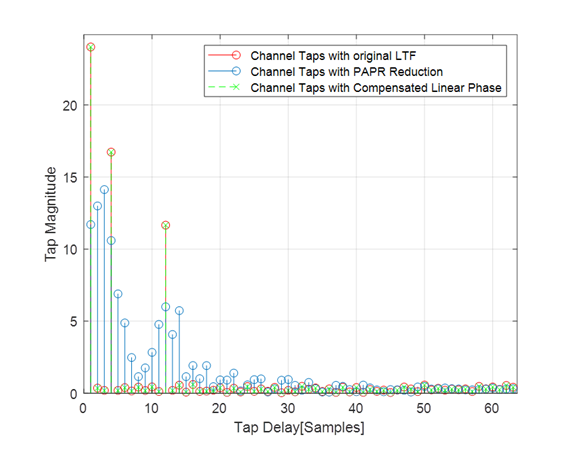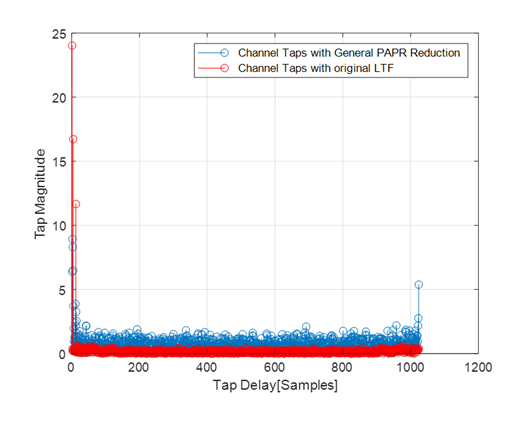Hi Ron,
Thanks for your response.
I think you are assuming a solution based on a single linear phase value per 80MHz segment.
Applying a single linear phase per 80MHz segment does not improve the Multi-RU PAPR, as we’ve shown in our contribution. This means all Multi-RU aggregations within 80MHz, such as 52+26, 106+26 and 242+484, will
still suffer from relatively high PAPR. Hence the solution would need to be different – for example, a different linear phase value, for each RU, within an 80MHz segment. Can a solution which is
not a single value per 80MHz be left out of the spec? I don’t think so (especially when considering the difference in used BW/RUs between an NDP and the following data PPDU).
Furthermore, you seem to also assume a per-80MHz (freq-domain) CHEST; keep in mind that whatever solution the transmitter employs for PAPR reduction, it needs to avoid degrading the receiver’s CHEST performance
(and various CHEST implementations may be employed).
Genadiy Tsodik
Algorithm Expert
Huawei TLV Research Center
Genadiy.tsodik@xxxxxxxxxx
Office: +972-74-7198101 | Mobile: +972-526773161 | fax: +972-9-9511218

From: Ron Porat [mailto:ron.porat@xxxxxxxxxxxx]
Sent: Wednesday, June 10, 2020 4:35 AM
To: Genadiy Tsodik (TRC) <genadiy.tsodik@xxxxxxxxxx>; STDS-802-11-TGBE@xxxxxxxxxxxxxxxxx
Subject: RE: [STDS-802-11-TGBE] Technical Discussion on doc 20/651
Hi Genadiy,
That wasn’t my claim. Let me clarify – if we specify in the spec that when frequency domain CSD is applied , one value is used for an entire 80MHz segment (but could be differentfrom segment to segment) and across
all Tx antennas the issues you raise won’t happen even if don’t specify the exact CSD value. The exact one CSD value per 80MHz segment will depend on the PPDU BW and puncturing modes and can be left outside the spec.
Thanks,
Ron
From: Genadiy Tsodik (TRC) [mailto:genadiy.tsodik@xxxxxxxxxx]
Sent: Monday, June 08, 2020 3:36 AM
To: Ron Porat; STDS-802-11-TGBE@xxxxxxxxxxxxxxxxx
Subject: RE: [STDS-802-11-TGBE] Technical Discussion on doc 20/651
Hi Ron,
Thanks for your prompt response.
If I understand your response correctly, your claim is that assuming PAPR reduction parameters are identical for all the streams (unlike what happens in an NDP), it will have no impact on CHEST.
In that case, let me explain again.
NDP CSD values indeed may differ from those of data PPDUs due to different Nss values, and therefore need to be compensated.
However, the problem we highlighted for PAPR reduction is slightly different. The plots shown in (3) correspond to the composite impulse response (caused by PAPR reduction transformation), and this is experienced
by every antenna. It means that a general PAPR reduction (transformation) may affect the CHEST of each stream independently.
Thus we need to be sure PAPR reduction transformation may be compensated by the receiver, regardless of the total number of streams.
Again, this is only a single aspect out of the 3 that we mentioned; note we mentioned also aspects (1) and (2) which also prevent PAPR reduction method from be transparent, for different reasons.
Please let me know if you have any further comments or insights.
Genadiy Tsodik
Algorithm Expert
Huawei TLV Research Center
Office: +972-74-7198101 | Mobile: +972-526773161 | fax: +972-9-9511218

From: Ron Porat [mailto:ron.porat@xxxxxxxxxxxx]
Sent: Thursday, June 4, 2020 10:43 PM
To: Genadiy Tsodik (TRC) <genadiy.tsodik@xxxxxxxxxx>;
STDS-802-11-TGBE@xxxxxxxxxxxxxxxxx
Subject: RE: [STDS-802-11-TGBE] Technical Discussion on doc 20/651
Hi Genadiy,
Thanks for the detailed email . Basically your nice plot below says that we need to put a spec limit to one CSD value per 80MHz to guarantee good performance. The NDP CSD is per stream, that’s different. Here
we are talking about one value in the frequency domain for all streams.
Thanks,
Ron
From: Genadiy Tsodik (TRC) [mailto:genadiy.tsodik@xxxxxxxxxx]
Sent: Thursday, June 04, 2020 1:38 AM
To: STDS-802-11-TGBE@xxxxxxxxxxxxxxxxx
Subject: [STDS-802-11-TGBE] Technical Discussion on doc 20/651
Hello 11be PHY colleagues,
Following the discussion during the presentation of contribution 20/651r2 (Further Thoughts on EHT-LTF PAPR in 802.11be) on Monday June 1st , I would like to clarify and emphasize the main issue respective to whether PAPR reduction
can be applied to the EHT-LTF sequences in a manner transparent to the receiver.
We showed that PAPR reduction should be applied to EHT-LTF sequences for specific Multi-RU cases and we claim it should be standardized to ensure both Tx and Rx side are aware of the exact transformation applied to the transmitted signal.
Explicit spec definition of this mechanism is required for several reasons:
1.
During NDP transmission, the beamformee is mandated by the spec (802.11n and beyond) to compensate/undo the CSD in order to ensure the physical channel is estimated. If the LTFs within the NDP undergo some type of transformation, it may yield a non-continuous
equivalent channel as seen by the receiver, and hence smoothing CHEST cannot be used. This means that the PAPR reduction method should be either known to the receiver (so it can ‘remove’ it) or should not prevent the application of smoothing CHEST. For example,
our proposed solution in 20/651 might be configured to allow channel smoothing application at the receiver (see slide 8).
2.
Moreover, the transmission of an NDP (specifically, the BW used and the value of N_SS) is not necessary aligned with the precoded data packets that follow it. For example, the used BW (e.g. RU used for the STA) may change between the NDP (where, for
example in the case of punctured NDP, 242+484 tones can be used) and the following precoded data packet (where only a 242-tone RU may be used). The application of the same PAPR reduction scheme during both NDP and data PPDU phases may be detrimental to the
performance.
3.
Focusing on the data PPDU only (ignoring the NDP), some receivers may apply channel estimation & smoothing methods (and/or time/tap domain processing). These methods can overcome (compensate) a single linear phase applied to the entire BW which results
in shift of the channel taps in tap-domain. However, a general PAPR reduction method may be seen as convolution with an arbitrary filter in the tap domain which cannot be compensated when the filter is unknown to receiver.
This means – again – that PAPR reduction may limit channel smoothing gain or even ruin the data detection.
In the figure below we show a noiseless estimation of a simple 3-taps channel, where the red curve corresponds to an MRU (242+484 tones) with no PAPR reduction,
the blue curve corresponds to the same signal with PAPR reduction (based on linear phase
per-RU suggested in 20/651) and the green curve corresponds to channel taps with single linear phase after compensation in the receiver. In this case (if the receiver is not aware of the sequence used at the transmitter side) channel smoothing gain
will be significantly lower.

Moreover assuming a general PAPR reduction method, it might result in a composite impulse response that is much longer than the CP which is ¼ symbol duration (see figure below). This means smoothing filter up to ¼ of OFDM symbol samples
(typical for WiFi), will be unable to compensate for this response and this will severely impact the performance.

We can see that the application of a generalized PAPR reduction scheme didn’t (cyclically) shift the channel taps – as would happen with a single linear phase applied in frequency domain – but instead created a more ‘complicated’ channel
for which it may be impossible to apply smoothing CHEST.
However, if the receiver knows the sequence used at the transmitter side, it can ‘remove’ it (similar to ‘removing’ CSD on the NDP) and perform CHEST.
Based on the above, we believe that PAPR reduction mechanism, applied on the specific cases of Multi-RU EHT-LTF with high PAPR, cannot be transparent to the receiver side and the spec should hence define the specific solution, be it whatever
we agree it should be.
Your comments and/or insights will be appreciated.
Genadiy Tsodik
Algorithm Expert
Huawei TLV Research Center
Office: +972-74-7198101 | Mobile: +972-526773161 | fax: +972-9-9511218

To unsubscribe from the STDS-802-11-TGBE list, click the following link:
https://listserv.ieee.org/cgi-bin/wa?SUBED1=STDS-802-11-TGBE&A=1
To unsubscribe from the STDS-802-11-TGBE list, click the following link: https://listserv.ieee.org/cgi-bin/wa?SUBED1=STDS-802-11-TGBE&A=1